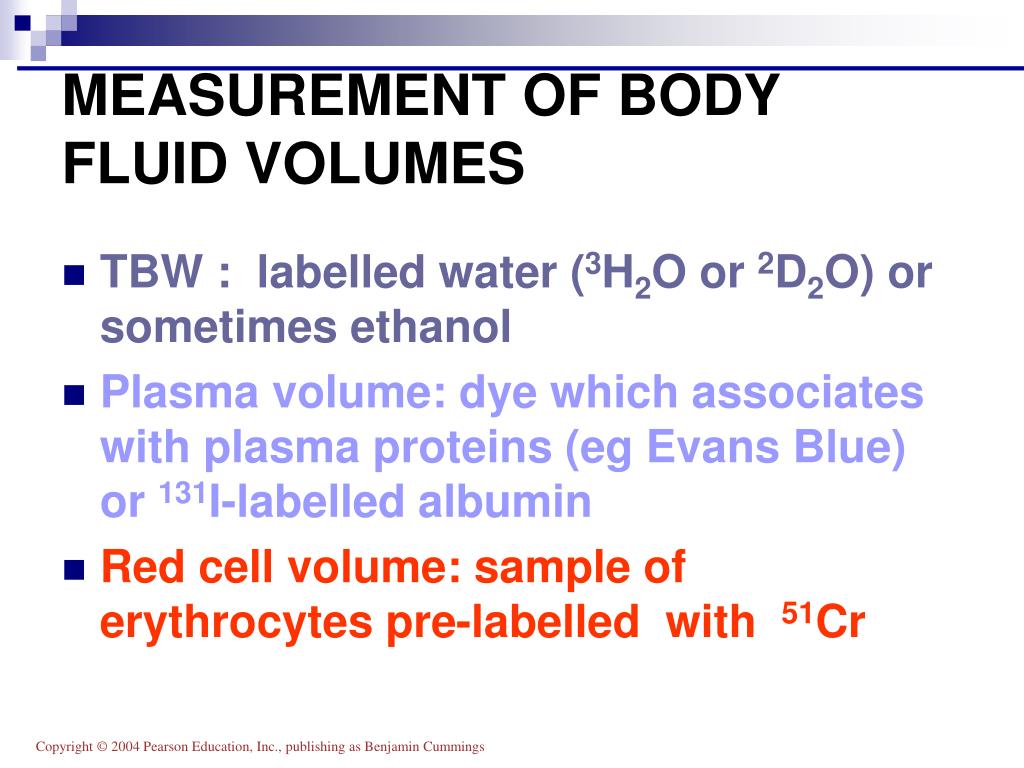

is to calculate the amount of Na+ in the infused volume, and then determine the. Thus, the intracellular fluid constitutes about 40 percent of the total body weight in an average person. This total body water (TBW) is contained within two major compartments. INTRACELLULAR FLUID COMPARTMENT About 28 of the 42 liters of fluid in the body are inside the 100 trillion cells and are collectively called the intra-cellular fluid.

BODY FLUID COMPARTMENTS CALCULATIONS SKIN
Insensible water loss: How much water loss via diffusion of skin 300-400 ml/day. computation of plasma volume were performed in a way similar to that of OBrien, Ibbot, and. To describe the major body fluid compartments, and the general processes involved. accordingly when considering body fluid compartments in most people. What is the definition of insensible water loss Water lost through skin or breathed out (can't sense its loss, as compared to feces or urine) 1) Loss thru skin via diffusion. 3, 4, 5 Note that 1 kg is equivalent to 2.2 lb, 1 inch is equivalent to 2.54 cm, and 1 L of water weighs 1 kg (2.2 lb). mining body fluid compartments must first be investigated. × ) and females’ lean body weight = 45.5 kg + (2.3 kg/in. 2 In obese patients, it is customary to estimate TBW using lean body weight or IBW as calculated by the Devine–Devine method: males’ lean body weight = 50 kg + (2.3 kg/in. Unless the patient is obese (body weight greater than 120% of ideal body weight ), clinicians typically use a patient’s actual body weight when calculating TBW. The percentage of TBW decreases as body fat increases and/or with age (75%–85% of body weight is water for newborns). For clinical purposes, most clinicians generalize that total body water accounts for 60% of lean body weight in adults, regardless of gender. >Interstitial Fluid: 15 Body Weight (75 of ECF) >Plasma: 5 Body Weight (25 of ECF) -The '20, 40, 60' rule provides an easy way of remembering the percentages of body weight within the ECF. The water content of the body and ratios of fluids. KEY CONCEPT TBW constitutes approximately 50% of lean body weight in healthy females and 60% of lean body weight in males. Total Body Water 60 Body Weight (2/3 TBW) -Intracellular Fluid: 40 Body Weight (1/3 TBW) -Extracellular Fluid: 20 Body Weight. Therefore, one frequently speaks of the sodium space or the inulin space, instead of calling the measurement the true extracellular fluid volume. Fluids are constantly exchanged between these compartments, moving across capillary walls and cell membranes. Most of these methods depend, in one form or an- other, on the tracer principle and the basic formula. Finally, the regulation of sodium is discussed with examination of the mechanisms controlling natriuresis and the reciprocity with potassium balance.The most fundamental concept to grasp is an assessment of total body water (TBW), which is directly related to body weight. other body fluid compartments have been developed. KAR from clear reduction in body water compartments was observed with Equation A8. The endogenous processes contributing to volume homeostasis are then deliberated including the detection of fluid imbalance through intracellular and extracellular systems as well as the hypothalamic and renal effector mechanisms. Body fluid volume determination via body composition spectroscopy in. In healthy lean people, the total body water comprises 50-60 of body weight in men and 45-50 of body weight in women.1 These differences in total body water percentage between men and women are because of women typically having less muscle mass and a greater amount of adipose tissue than men.

The way in which clinically administered fluids of varying compositions affect the fluid compartments is subsequently discussed. To illustrate daily fluid balance in a healthy individual, a typical intake and output over 24 hours is quantified before consideration of iatrogenic contributions to this equilibrium. The differences in ionic concentration between intracellular and extracellular fluid are quantified and the effects of greater relative protein concentration within cells are also considered. i) DILUTION PRINCIPLE: If a substance of known concentration and volume is injected into a persons blood stream and a. Furthermore, the potential disadvantages to the approach are discussed. Here, the calculation of these volumes by measuring the dilution of markers able to permeate specific compartments is considered. Dilution method, Evans blue dilution, Deuterium dilution, Sodium bromide dilution, Total body potassium, Bioimpedance AnalysisPhysiologylecturesGeneralPhys. The dynamic balance across these compartments is an essential component of normal physiology. The water contained in the body is divided amongst compartments of differing sizes and compositions. To evaluate TBW, ECW and ICW by the fluid volume model, the BCM defines extracellular and total body resistance by the.


 0 kommentar(er)
0 kommentar(er)
